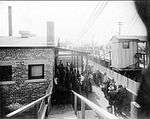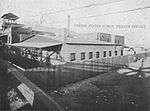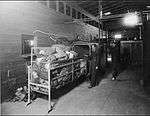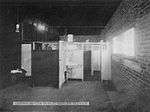1917 Bath Riots




1917 Bath Riots occurred in January 1917 at the Santa Fe Bridge between El Paso, Texas and Juárez, Mexico. The riots lasted from January 28 to January 30 and were sparked by new immigration policies at the El Paso–Juárez Immigration and Naturalization Service office, requiring Mexicans crossing the border to take de-lousing baths and be vaccinated. Reports of nude photography of women bathers and fear of potential fire from the kerosene baths led Carmelita Torres to refuse to submit to the procedure. Denied a refund of her transport fare, she began yelling at the officials and convinced other riders to join her. After three days, the discontent subsided, but the disinfections of Mexicans at the U.S. border continued for forty years.

Background
By 1914, Venustiano Carranza had been sworn into office as Mexico's head of state ending the main fighting of the Mexican Revolution. President Woodrow Wilson, tired of the fighting and more concerned with events unfolding in Europe and World War I, withdrew American forces from Mexico. Pancho Villa refused to give up the fight and continued to execute border skirmishes.[1] Between 1915 and 1917, typhus (which was sometimes reported as typhoid fever) spread from Mexico City to the provinces from Veracruz to Jalisco.[2] In September 1916, Carranza called for a constitutional convention to end the conflict and bring peace to Mexico.[3] The convention ended simultaneously with the end of the riots, on January 31, 1917,[4] and subsequently the new constitution was signed on February 5.[5]
During the same period, Thomas Calloway Lea, Jr. was elected as mayor of El Paso, Texas. Lea sent telegrams to U.S. Senators in Washington demanding a quarantine be put in place to stem the tide of "dirty lousey destitute Mexicans" who would spread typhus into El Paso.[6] Though the Public Health Service Officer for El Paso, Dr. B. J. Lloyd, admitted there was little danger and opposed a quarantine, he suggested opening de-lousing plants.[7] U.S. officials quickly adopted a policy of sanitizing Mexican immigrants at a disinfecting station in El Paso. The policy initially applied to all Mexicans entering the United States at El Paso,[8] but soon spread to the Laredo–Nuevo Laredo crossing, as well as all along the U.S. Mexico border.[9]
Men and women were separated, with any children accompanying the women, into separate buildings, where they were stripped of all clothing and valuables. Clothing and valuables were steamed, while items like shoes, hats or belts, which might be damaged by steam were exposed to cyanogen gas. Attendants examined the nude persons for lice. If lice were found, men's hair was clipped close to the head and the clippings were burned. Women's hair was doused in a mixture of vinegar and kerosene, wrapped in a towel, and left on the hair for at least 30 minutes. If re-inspection indicated all nits had not been removed, the process was repeated. Once attendants declared the lice test had been "passed", the naked people were gathered in a bathing area and sprayed with a liquid soap made of soap chips and kerosene oil.[8] After collecting their sanitized clothing and dressing, incomers were evaluated by a foreman, vaccinated and given a certificate that they had completed the procedure. From the disinfecting area, migrants then entered the Immigration and Naturalization Service building for processing.[10]
Riot
Around 7:30 a.m.[11] on January 28, 1917, the riot began when inspectors attempted to remove Mexican women from their trolley, which they were riding to work. Ordered to disembark and submit to the disinfection process, Carmelita Torres refused, having heard reports that nude women were being photographed while in the baths.[12] Reports had also circulated that bathers might be set on fire, as had happened the previous year when gasoline baths at the El Paso City Jail had resulted in the death of 28 inmates when a cigarette ignited bathers.[13] She requested permission to enter without submitting to bathing and was refused. She then demanded a refund of her fare and upon refusal of a refund convinced the other women on her cable car to protest. The women began shouting and hurling stones at health and immigration officials, sentries and civilians, who had gathered to watch the disturbance. The majority of the early protesters were young, domestic workers employed in homes in El Paso but as the crowd grew to several thousand a mixture of people became involved. Four trolley's which had made early morning runs to collect workers on the Juárez side were seized and did not return to the El Paso side until mid-afternoon.[12]
Around 10 o'clock, General Andrés G. García drove to the center of the bridge to try to quiet the mob and was only partially successful, as the mob tried to prevent his car from leaving the Mexican side. By the afternoon, when it was clear that those who had entered the baths were not being harmed, the crowds were finally dispersed by mounted soldiers on each side of the border.[12] One cable car motorman and a mail coach driver were reported to have been beaten by rioters and several media movie makers were attacked.[14] Despite rumors that someone had been shot, Mexican authorities denied the event and reported that no serious injuries resulted.[15]
On the 29th rioting continued, but this time, the majority of rioters were men. Newspapers reported that the men were taking advantage of the bath disturbance to protest the Carranza regime and voice support for his rival Pancho Villa. Juárez Police Chief Maximo Torres ordered all rioters arrested and the Mexican cavalry dispersed the rioters from the bridge.[16] Business owners and households who were without laborers consulted with the Chamber of Commerce to resolve the issues promptly as most workers refused to come to work. Officials clarified that those who were not infected could be passed without having to bathe and that certificates were valid for a week.[17]
By January 30, precautionary measures taken by authorities on both sides of the border had quelled the rioting.[18] Two men and one woman were arrested at the American side of the bridge for assaulting a customs officer and an infantryman, but no further violence was reported.[19] Policemen from Juárez monitored the southern end of the bridge crossing, a Mexican health inspector Andrés García was present to maintain respectful treatment at the disinfection plant, and street car service between the two cities was suspended.[18] Notices had been posted in Juárez to advise that the inspectors in El Paso would accept health certificates issued by Mexican health inspectors.[20]
Legacy
Though hailed by some as the "Latina Rosa Parks", Carmelita Torres was mostly forgotten and her actions had little lasting effect.[7] The Immigration Act of 1917 passed just days after the riot and imposed barriers for Mexican laborers entering the United States. For the first time in history, workers were required to pass literacy tests, pay a head tax and were forbidden to perform contract labor.[21] Business owners in the Southwest pressed Congress to exempt Mexican workers from contract labor restrictions and head taxes. After the U.S. entered World War I businessmen were able to lift the 1917 Immigration terms for Mexican workers and the exemption lasted until 1921.[22] However, the bathing and fumigations, which later used insecticides and DDT continued into the 1950s.[7] A similar riot the following year was averted when prompt action by Mexican authorities intervened with American authorities. Reports of a typhus death in Juárez were denied by Mexicans and the port and trolleys were temporarily closed to prevent altercations.[23]
In 2006, David Dorado Romo published Ringside Seat to a Revolution which brought the story back to the attention of the public and Chicano scholars.[7][24] National Public Radio featured a story on the riots in 2006.[7]
References
Citations
- ↑ Beller 2008, pp. 44, 46.
- ↑ Knight 1990, p. 421, 623.
- ↑ Beller 2008, p. 46.
- ↑ Beller 2008, p. 47.
- ↑ Beller 2008, p. 112.
- ↑ Perez, Jr. 2016.
- 1 2 3 4 5 Burnett 2006.
- 1 2 Pierce 1917, p. 427.
- ↑ Pierce 1917, p. 429.
- ↑ Pierce 1917, p. 428.
- ↑ The El Paso Herald & January 29, 1917, p. 1.
- 1 2 3 The El Paso Morning Times & January 29, 1917, p. 1.
- ↑ The Detroit Free Press 1917, p. 2.
- ↑ The Detroit Free Press 1917, pp. 1, 2.
- ↑ The Times Dispatch 1917, p. 1.
- ↑ The Elyria Evening Telegram 1917, p. 5.
- ↑ The El Paso Morning Times & January 30, 1917, pp. 1, 2.
- 1 2 The Reno Evening Gazette 1917, p. 1.
- ↑ The Fort Wayne Sentinel 1917, p. 32.
- ↑ The Iowa City Citizen 1917, p. 2.
- ↑ Powell 2009, p. 137.
- ↑ Coerver, Pasztor & Buffington 2004, p. 224.
- ↑ The El Paso Herald 1918, pp. 1, 5.
- ↑ Acuña 2012.
Bibliography
- Acuña, Rodolfo (August 30, 2012). "The Gas Bath Riot and Other Tales of Mexican-American Resistance". Petrolia, California: CounterPunch. Archived from the original on 1 September 2012. Retrieved 11 September 2016.
- Beller, Susan Provost (2008). The Aftermath of the Mexican Revolution. Minneapolis, Minnesota: Twenty-First Century Books. ISBN 978-0-8225-7600-6.
- Burnett, John (January 28, 2006). "The Bath Riots: Indignity Along the Mexican Border". National Public Radio. Washington, D.C. Archived from the original on 2 February 2006. Retrieved 11 September 2016.
- Coerver, Don M.; Pasztor, Suzanne B.; Buffington, Robert (2004). Mexico: An Encyclopedia of Contemporary Culture and History. Santa Barbara, California: ABC-CLIO. ISBN 978-1-57607-132-8.
- Knight, Alan (1990). The Mexican Revolution. II. Counter-revolution and reconstruction. Lincoln, Nebraska: University of Nebraska Press. ISBN 0-8032-7771-7.
- Perez, Jr., Maclovio (July 30, 2016). "El Paso Bath House Riots (1917)". Handbook of Texas Online. Austin, Texas: Texas State Historical Association. Archived from the original on 11 September 2016. Retrieved 11 September 2016.
- Pierce, C. C. (March 23, 1917). "Combating Typhus Fever on the Mexican Border". Public Health Reports. Washington, D. C.: Association of Schools of Public Health. 32 (12): 426–429. doi:10.2307/4574464. ISSN 0094-6214. JSTOR 4574464.
- Powell, John (2009). Encyclopedia of North American Immigration. New York, New York: Infobase Publishing. ISBN 978-1-4381-1012-7.
- "200 Women Lead in Assault at Bridge". El Paso, Texas: The El Paso Herald. January 29, 1917. Retrieved 12 September 2016.
- "990 Mexicans All Survive After Bath". Fort Wayne, Indiana: The Fort Wayne Sentinel. January 31, 1917. Retrieved 12 September 2016 – via Newspaperarchive.com.

- "Auburn-Haired Amazon at Santa Fe Street Bridge Leads Feminine Outbreak". 37th year (1 (English Edition)). El Paso, Texas: The El Paso Morning Times. January 31, 1917. Retrieved 12 September 2016.
- ""Bath Riot" at Bridge is Averted, but Port is Shut by Order of Juarez Mayor". El Paso, Texas: The El Paso Herald. September 27, 1918. Retrieved 12 September 2016 – via Newspapers.com.


- "Bath Rioting Renewed at Santa Fe Bridge (pt 1)". El Paso, Texas: The El Paso Morning Times. January 30, 1917. Retrieved 12 September 2016. and "Bath Rioting Renewed at Santa Fe Bridge (pt 2)". El Paso, Texas: The El Paso Morning Times. January 30, 1917. Retrieved 12 September 2016.
- "Blame Villa's Men for Juarez Rioting". Elyria, Ohio: The Elyria Evening Telegram. January 31, 1917. Retrieved 12 September 2016 – via Newspaperarchive.com.

- "Mexican "Bath Riots" End". Iowa City, Iowa: The Iowa City Citizen. January 31, 1917. Retrieved 12 September 2016 – via Newspaperarchive.com.

- "Mexicans Resent Orders to Bathe". Richmond, Virginia: The Times Dispatch. January 29, 1917. Retrieved 12 September 2016 – via Newspapers.com.

- "Servant Girl Problem in El Paso". Reno, Nevada: The Reno Evening Gazette. January 30, 1917. Retrieved 12 September 2016 – via Newspaperarchive.com.

- "Women Force Anti-American Riot in Juarez (pt 1)". Detroit, Michigan: The Detroit Free Press. January 29, 1917. Retrieved 12 September 2016 – via Newspapers.com.

